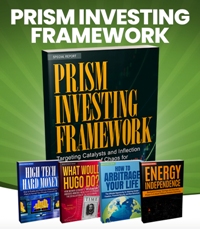 Rising consumer prices, rising unemployment, and a slowing economy are telltale signs of stagflation. This is the ugly scenario that is unfolding before our very eyes. Where a person must work more to get less. And that’s if they don’t lose their job.
Rising consumer prices, rising unemployment, and a slowing economy are telltale signs of stagflation. This is the ugly scenario that is unfolding before our very eyes. Where a person must work more to get less. And that’s if they don’t lose their job.
The Federal Reserve’s preferred inflation indicator, the personal consumption expenditures (PCE) price index, recently showed consumer prices increased at an annual rate of 2.5 percent in February. If you exclude food and energy, the PCE price index increased at an annual rate of 2.8 percent.
Of note, the latest PCE price index does not include price hikes from Trump tariffs. Those price hikes are forthcoming. Moreover, the additional costs of Liberation Day tariffs will most definitely compel consumer price inflation higher.
For example, all goods made in China will now be subject to a 54 percent tariff. So, if you shop at Walmart, Target, or any other store that stocks its shelves with goods from China, you will be paying much, much more.
Of course, rising consumer prices always come at the worst possible time. And this time is no exception. Right now, consumers are tapped out.
Specifically, consumer spending increased by just 0.4 percent in February. When combined with the 0.3 percent decline in January, this has marked the weakest two-month stretch since the coronavirus fiasco in 2020.
Consumer spending accounts for over two-thirds of economic activity. As consumer spending slows, the economy also slows, and unemployment rises. Then, with less people working and earning income, consumer spending will continue to fall. Thus, a self-reinforcing cycle of slow or declining growth and rising unemployment will be established.
This is the fate that awaits American workers and consumers. Yet it should come as no surprise…
Serious Delinquency
American consumers have been stretched to the max for well over a year. In fact, a survey of more than 1,000 Americans released by Bankrate found that 37 percent of them had to dip into their emergency savings in the past year. Of those, 80 percent used the money for essential expenses. This included paying monthly bills and buying food, water, and household goods.
Emergency savings, by definition, are for emergencies. Things like repairs for a blown head gasket. Or medical bills for a broken arm. Or to replace a refrigerator that’s on the fritz. These are the type of unexpected expenses that emergency savings are generally used for.
Using emergency savings for routine bills and to buy the basics like food and water is an indication that something’s not right. Another indication is the massive number of credit cards that are in serious delinquency, which is defined as late payments of more than 90 days. Currently, they’re at levels that are typically reached during recessions.
As reported by the New York Fed, Americans now hold a record $1.2 trillion in credit card debt. And in the fourth quarter of 2024, the share of credit card balances that are 90 days or more delinquent hit 11.35 percent. That’s the highest rate of credit card delinquencies since late 2011.
In other words, these credit card holders aren’t even paying the monthly minimums. They’re paying nothing at all. In doing so, they’re destroying their credit rating and their ability to borrow in the future.
Rising consumer price inflation, increased layoffs, and credit card defaults are a rough storyline. They all point to stagflation and a burgeoning recession.
#RecessionIndicator
Goldman Sachs recently raised its prediction of the likelihood of a U.S. recession to 35 percent. The investment bank’s rationale was the tax-like impact on consumers that will come from higher tariffs. Not to be outdone, JPMorgan has raised the odds of a recession to 40 percent for many of the same reasons.
Perhaps these forecasts do not appreciate the risk of recession. At this point the odds should be well above 35 or 40 percent. In reality, the U.S. economy may already be in a recession.
The latest forecast of 14 economists surveyed by CNBC puts first-quarter GDP growth at 0.3 percent. That’s barely treading water. And this is before Trump’s Liberation Day tariffs have kicked in.
Once the cost of these tariffs and tariff related uncertainty has a chance to filter its way through prices and supply chains, the economy will undoubtedly slip into contraction. After this happens for two consecutive quarters then the recession will be official.
In the meantime, Gen Z and young millennials have taken to posting what they believe are observable recession indicators on social media. These posts are tagged with #RecessionIndicator. Everything from music, to fashion, to tipping culture is posted as evidence of a recession.
“We’re starting fresh with our District 12 frock,” remarked one Gen Z social media content creator. “It’s made out of a nice rough material… It doesn’t need washing that often. That is recession-core.”
If Gen Z considers a simple dress to be recession-core what will they consider a steady diet of rice and beans?
When Bank of Mom and Dad Goes Broke
Without question, this economic environment has been especially brutal for young adults. A study from savings.com recently found that half of parents with adult children provide regular assistance to their grown progeny. The average support per adult child coming from “Bank of Mom & Dad” is $1,474 per month – or about $18,000 per year.
Parents are sacrificing their retirement savings to buy groceries and pay cell phone bills and rents or mortgages for their adult children. Per savings.com:
“The financial strain of supporting grown children is particularly pressing for parents preparing a nest egg. Parents still in the workforce contribute over two times more money to their adult children each month than their retirement accounts.”
What will happen when mom and dad retire or run out of money to support their adult children? Will the kids somehow become self-supporting through gainful employment? Will they return the favor to their parents after siphoning off their retirement savings?
These are the types of unpleasant questions that must be asked when society falls into decline. As things break down, they no longer function along conventional lines. Established norms and expectations are shattered.
Parents are called upon to support their adult children until the bank of mom and dad goes broke. So, too, credit card defaults pile up. And, eventually, if enough people cannot pay their debts the entire debt structure breaks down. Banks fail. Bank assets get vaporized.
To reverse course, the U.S. economy needs lower consumer prices and more high paying jobs. This would allow workers and consumers to maintain a reasonable lifestyle without drowning in debt or relying on the bank of mom and dad. Trump believes tariffs are the answer.
If only it were so.
[Editor’s note: Have you ever heard of Henry Ford’s dream city of the South? Chances are you haven’t. That’s why I’ve recently published an important special report called, “Utility Payment Wealth – Profit from Henry Ford’s Dream City Business Model.” If discovering how this little-known aspect of American history can make you rich is of interest to you, then I encourage you to pick up a copy. It will cost you less than a penny.]
Sincerely,
MN Gordon
for Economic Prism
Return from When Bank of Mom and Dad Goes Broke to Economic Prism




